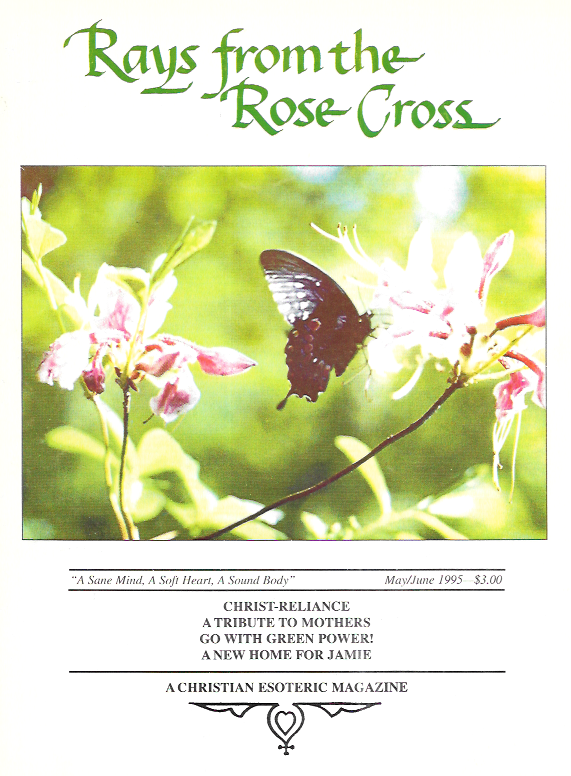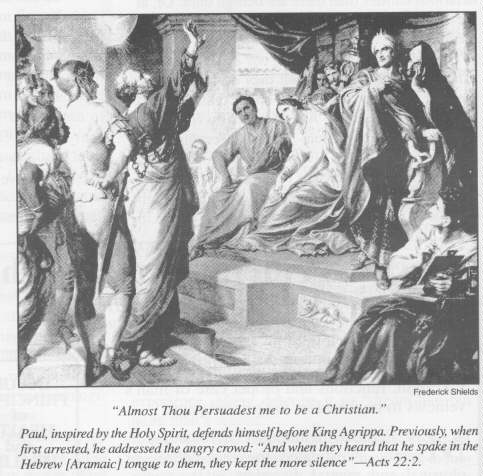Rays From The
Rose Cross Magazine
Book Reviews
The Peshitta
A New Look at
an Old Book
The Christian Bible has been used as the alibi and authority for
virtually every conceivable course of human action-from waging
war, to promoting vegetarianism, to condoning polygamy, to proving
the vanity of all effort. Part of the problem in citing Scripture
is due to the proliferation of texts all purporting to be the
Bible.
While the King James version is the most popular rendition in
the English language, it was produced by forty-seven translators,
only three of whom, as Max Heindel states, knew Hebrew. And two
of them died before the Psalms was translated. Even at that, the
Hebrew text used as their source, the Talmud, had not been compiled
before 500 A.D., at it came from a variety of sources. Only several
centuries later was a Masoretic text composed in which vowels
were inserted to open up the exclusively consonantal form in which
the earlier version was written.
Moreover, the Greek Septuagint, on which most Bible versions have
been based, already was derivative and fraught with interpretations
and distortions of Hebrew words and idioms. Written by seventy-two
Palestinian scholars in seventy days (it is alleged) for cosmopolitan
Alexandrian Jews, the Septuagint served as the basis for a retranslation
into Hebrew, since the original Hebrew Old Testament texts had
been lost.
Martin Luther's German Bible was a translation of St. Jerome's
Latin Bible, itself based on the Greek. When words are so wrought
and wrenched through various linguistic filters, one can but marvel
that Christian Scripture has survived as intact as it appears
to be.
Some of the confusion and ambiguity arising from the plethora
of derivative texts has been obviated with George Lamsa's translation
of the Peshitta (Harper Collins, San Francisco, 1968) from the
Aramaic. Completely unknown to the West before Great Britain's
military and political ascendancy in India and the East in the
nineteenth century, the complete Peshitta was not translated until
1933.
The term peshitta means straight, simple, sincere, and true; that
is, original. It was so named to distinguish it from other Bible
revisions and translations. It contains the Apocrypha, which "a
few wiseacres" delegated to "the literary scrap heap"
(Heindel).
One of the world's most ancient languages, Aramaic was the language
of the Semitic culture, the Hebrew prophets, and the lingua franca
of the Fertile Crescent from the seventh century B.C. to about
the sixth century A.D. Jesus and his disciples spoke the Galilean
dialect of Aramaic. Mark tells us (14:70) that Peter was exposed
when in Caiphas' house by speaking this tongue.
On his journeys Paul preached the Christian Gospel written in
Aramaic. He always spoke in Jewish synagogues and his first converts
were Hebrews. His epistles were originally written in Aramaic
(though this is disputed by some western scholars, often protecting
vested interests) to small Christian congregations comprised mostly
of Jews of the dispersion. Paul emphasized Hebrew law, Jewish
ordinances, and temple rituals, matters of no interest to non-Jews.
Josephus, writing in the middle of the first century A.D., states
that even though "there have been many [Jews] who have done
their endeavors, with great patience, to obtain this Greek learning,
there have yet hardly been two or three who have succeeded herein."
Indeed, the teaching of Greek was forbidden by Jewish rabbis.
It was said that it was better for a man to give his child meat
of swine, taboo pork, than to teach him the language of the Greeks.
It is instructive for us to remember that the Bible was written
as an Eastern book primarily for the Israelites, and only subsequently
was it made accessible to the gentile world. Paul's letters, for
instance, were translated into Greek for the use of converts who
spoke Greek. As Luke writes in Acts 22:2, Paul defended himself
in his own tongue.
The foregoing establishes Aramaic as the Bible language. The oldest
dated (464 A.D.) biblical manuscript in the world, written in
Aramaic, is that of the four Books of Moses, preserved in the
British Museum. Aramaic, whose literary form was called Syriac,
was the language of the church that spread eastward almost from
the beginning of Christianity in Antioch (in present-day Syria),
where the term Christian was first used to denominate the followers
of Christ Jesus. Aramaic differed from the Hebrew language of
Palestine as American English differs from British English.
Lamsa, in his introductory remarks to the Peshitta translation
says that one would no more talk of translations between the sister
languages of Aramaic and Hebrew than one would speak of translating
Higher to Lower German. The term Hebrew itself is derived from
the Aramaic Abar or Habar, meaning to cross over, referring to
those Hebrew people who, following Abraham from Ur in Chaldea,
crossed over the Euphrates River westward and went to Palestine,
The Hebrews were "the people across the river."
While Easterners still adhere to God's commandment not to add
to or omit a word from the Scriptures (Deut. 4:2, 12:32; Prov.
30:6; Rev. 22:19), translations from Semitic languages into Greek
and Latin were subject to constant revision. Learned men who copied
them introduced changes, trying to simplify obscurities and ambiguities
which were due to the work of the first translators.
The foregoing observations give grounds for regarding the Peshitta
as quite possibly the text least altered and most faithful to
the original Biblical texts. From an occult point of view, we
can find confirmation for this claim in the text itself. Aramaic
may be the richest and most expressive language of the Semitic
group, but it has a small vocabulary compared to Latin and Greek.
This limitation was compensated for by assigning many shades of
meaning to the same word and by the use of dots.
Max Heindel regards this use of semiotics and nonvowel text as
evidence of "the transcendental wisdom of the wonderful Intelligences
Who inspired the Torah," for it conceals and protects even
as it enriches meaning by allowing for variant readings and multiple
perspectives. "Had the vowels been inserted and a division
made into words, there would have been only one way of reading
it and these grand and sublime mysteries could not have been hidden
therein." For the Old Testament was not written as an "open"
book of God but was intended for the initiated (Cosmo, 322).
Consider, however, the effect produced by confusing the reference
of dots to their intended words. The only difference between the
Aramaic words "learned man" and "stupid man"
is a dot over or under the same word, respectively. And these
dots could result inadvertently by the pressing together of manuscripts
in humid climate or by the accumulation of extrinsic marks and
spots. Frequently the same words will have different meanings
according to the context. Also, some of the most significant mistranslations
were due to the confusion of nearly identical letters and words.
For instance, the bizarre comparison in which it is said (Matt.
19:24) that it is easier for a camel to go through the eye of
a needle than for a rich man to enter the kingdom of heaven is
due to the translator's failure to identify the other relevant
meaning of the Aramaic word gamla, rope!
Many Aramaic idioms were translated into Greek and other languages
literally, losing the sense of the passage or even obscuring it
altogether. The clause in the Lord's Prayer conventionally rendered
"and lead us not into temptation" has been restored
to its original meaning with "and do not let us enter into
temptation." The thought that God would and does lead his
children into temptation is inadmissible, and Bible exegetes have
gone to great lengths in trying to justify the mistranslation.
The passage in Luke (9:59) in which the young man insists on "burying"
his father before he follows Christ ignores the idiom that should
read "take care of until death." How much more demanding
is Christ's call in terms of this rendering, since the father
is still alive and exerts much more legitimate claim on his son's
ministrations.
A passage that has caused considerable difficulty is resolved
by the Peshitta Bible. Christ Jesus on the cross (Mark l5:34)
does not say "My God, why hast thou forsaken me," but
"this was my destiny." How much better does this translation
accord with what we would expect the archangelic Regent of the
Sun to say, even under such dire conditions. For that pivotal
moment in Earth's history had been prepared for over millennia.
Again, confirming Heindel's own reading of problematic words of
the crucified Jesus to the thief on His right, "I say to
thee today, thou shalt be with me in Paradise." The Greek
language did not employ punctuation and the translator(s) elected,
erroneously, to place the comma before, rather than after, today,
contradicting our knowledge that Christ descended into the earth
before he ascended into heaven.
The Aramaic idiom translated in standard English versions as turning
the other cheek actually means "do not start a quarrel or
a fight." In other words, one need not be quite as supinely
accepting of violence inflicted upon one's person as the traditional
translation suggests. Other examples of clarified translations
include "in my Father's house are many rooms" (John
14:2) and "I will not leave you bereaved" (John l4:18).
Our last illustration is particularly illuminating: "No man
has even seen God; but the first-born of God, who is in the bosom
of his Father, he has declared him" (John l:18). "First-born"
(also used in John l:14-"first-born of the Father")
more conforms with Paul's description of Christ as our "elder
brother" and the "first fruits," thus promising
an immeasurably magnified destiny for man in terms of his cognate
origin in the Father, his current status as sharing brotherhood
in and with Christ, and his future prospect as a Son of the Father.
The Peshitta offers many similar flashes of clarity and intrinsic
confirmations of authenticity. This reviewer would not propose
that it replace all other translations of the Bible, for the King
James edition in particular is an inspired text, compensating
by diction and rhythm — its poetic vision — what it occasionally lacks
in fidelity to the original sense. The judicious use of several
versions of Scriptures will enhance our understanding of the sacred
Word — until such time as we may read it directly and infallibly
from the memory of nature.
— C.W.
— Rays from the Rose Cross Magazine, March/April, 1996
This web page has been edited and/or excerpted from reference material, has been modified from its original version, and is in conformance with the web host's Members Terms & Conditions. This website is offered to the public by students of The Rosicrucian Teachings, and has no official affiliation with any organization.



